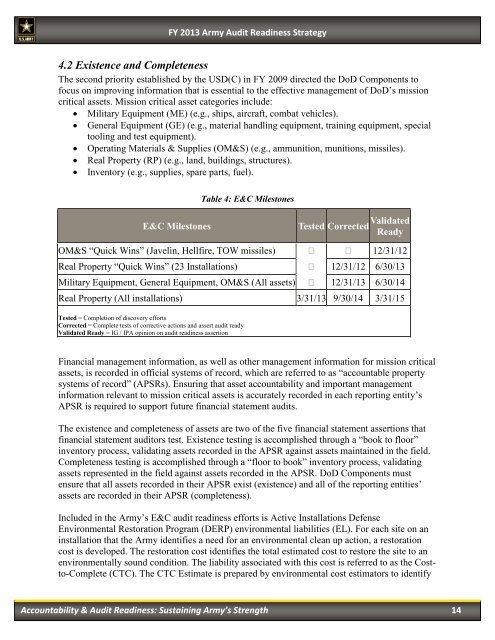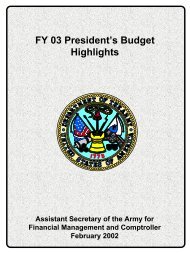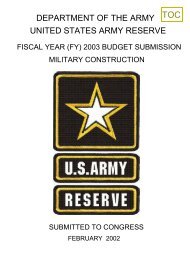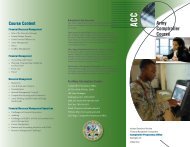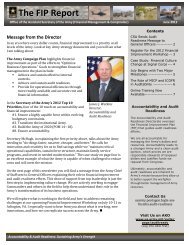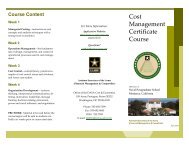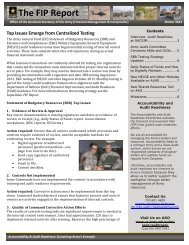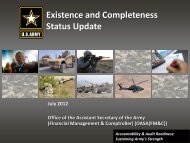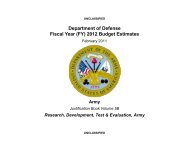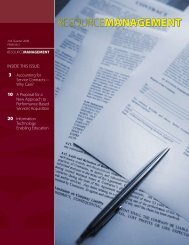Army Audit Readiness Strategy FY 2013 - Army Financial ...
Army Audit Readiness Strategy FY 2013 - Army Financial ...
Army Audit Readiness Strategy FY 2013 - Army Financial ...
You also want an ePaper? Increase the reach of your titles
YUMPU automatically turns print PDFs into web optimized ePapers that Google loves.
<strong>FY</strong> <strong>2013</strong> <strong>Army</strong> <strong>Audit</strong> <strong>Readiness</strong> <strong>Strategy</strong><br />
4.2 Existence and Completeness<br />
The second priority established by the USD(C) in <strong>FY</strong> 2009 directed the DoD Components to<br />
focus on improving information that is essential to the effective management of DoD’s mission<br />
critical assets. Mission critical asset categories include:<br />
Military Equipment (ME) (e.g., ships, aircraft, combat vehicles).<br />
General Equipment (GE) (e.g., material handling equipment, training equipment, special<br />
tooling and test equipment).<br />
Operating Materials & Supplies (OM&S) (e.g., ammunition, munitions, missiles).<br />
Real Property (RP) (e.g., land, buildings, structures).<br />
Inventory (e.g., supplies, spare parts, fuel).<br />
Table 4: E&C Milestones<br />
E&C Milestones<br />
Tested Corrected Validated<br />
Ready<br />
OM&S “Quick Wins” (Javelin, Hellfire, TOW missiles) 12/31/12<br />
Real Property “Quick Wins” (23 Installations) 12/31/12 6/30/13<br />
Military Equipment, General Equipment, OM&S (All assets) 12/31/13 6/30/14<br />
Real Property (All installations) 3/31/13 9/30/14 3/31/15<br />
Tested = Completion of discovery efforts<br />
Corrected = Complete tests of corrective actions and assert audit ready<br />
Validated Ready = IG / IPA opinion on audit readiness assertion<br />
<strong>Financial</strong> management information, as well as other management information for mission critical<br />
assets, is recorded in official systems of record, which are referred to as “accountable property<br />
systems of record” (APSRs). Ensuring that asset accountability and important management<br />
information relevant to mission critical assets is accurately recorded in each reporting entity’s<br />
APSR is required to support future financial statement audits.<br />
The existence and completeness of assets are two of the five financial statement assertions that<br />
financial statement auditors test. Existence testing is accomplished through a “book to floor”<br />
inventory process, validating assets recorded in the APSR against assets maintained in the field.<br />
Completeness testing is accomplished through a “floor to book” inventory process, validating<br />
assets represented in the field against assets recorded in the APSR. DoD Components must<br />
ensure that all assets recorded in their APSR exist (existence) and all of the reporting entities’<br />
assets are recorded in their APSR (completeness).<br />
Included in the <strong>Army</strong>’s E&C audit readiness efforts is Active Installations Defense<br />
Environmental Restoration Program (DERP) environmental liabilities (EL). For each site on an<br />
installation that the <strong>Army</strong> identifies a need for an environmental clean up action, a restoration<br />
cost is developed. The restoration cost identifies the total estimated cost to restore the site to an<br />
environmentally sound condition. The liability associated with this cost is referred to as the Costto-Complete<br />
(CTC). The CTC Estimate is prepared by environmental cost estimators to identify<br />
Accountability & <strong>Audit</strong> <strong>Readiness</strong>: Sustaining <strong>Army</strong>’s Strength 14


